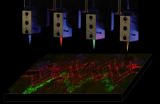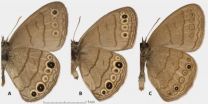(Press-News.org) VIDEO:
The Kuehner lab demonstrates their drug-screening technique in JoVE's peer-reviewed video format to aid other researchers in the field.
Click here for more information.
February 19—Researchers from the Franciscan University of Steubenville, Ohio are exploring a possible link between metabolic defects and seizures. They determined that diet could influence susceptibility to seizures, and they have identified a common diabetes drug that could be useful in treating disorders such as epilepsy.
Dr. Daniel Kuebler, the principal investigator behind the experiment, and his lab made the connection by measuring fruit fly movement with inexpensive web-cams. They have published a peer-reviewed, video demonstration of their method in JoVE, the Journal of Visualized Experiments, to assist others in reproducing and further applying the method.
"This technique has allowed us to identify a number of metabolism-altering drugs that affect seizure susceptibility," said Dr. Kuebler, "It has opened up a new line of research looking at the effect dietary modifications have on seizure susceptibility." As published in the article, his lab team determined that metformin, a drug commonly used to treat type II diabetes, reduces the intensity of seizures.
The drug-screening model system is especially ideal for labs on a tight budget, said Dr. Kuebler. According to the article, "Video tracking systems have been used widely to analyze Drosophila melanogaster movement and detect various abnormalities in locomotive behavior. [But] while these systems can provide a wealth of behavioral information, the cost and complexity of these systems can be prohibitive for many labs." Unlike similar experiments, which study the behavior of these flies in aggregate, Dr. Kuebler and his team's approach studies fly behavior one at a time. This is beneficial in that it can determine subtle differences in behavior and seizure alterations, he said.
While there is no known trigger behind seizures in people with epilepsy, Dr. Kuebler and his lab are using their drug-screening technique to investigate potential metabolic causes—using genetically modified, seizure-prone flies (a family of Drosophila flies called Bang-sensitive paralytic mutants). "It is well known that certain diets, such as the ketogenic diet, have effects on seizures, but there is little agreement on the mechanism behind this diet," said Dr. Kuebler, "This technique allows us to better address this question."
Dr. Kuebler chose to publish his method in a video format because of its capacity to communicate scientific procedures better than text. "The ability to show the seizure behavior visually, [showing] exactly how the recording is done, made the journal a much more attractive option than print only journals," said Dr. Kuebler, "This low cost system is simple enough to set up in an undergraduate teaching lab and can allow for students to do some inquiry based learning labs on a budget."
INFORMATION:
About JoVE, The Journal of Visualized Experiments:
JoVE, the Journal of Visualized Experiments, is the first and only PubMed/MEDLINE-indexed, peer-reviewed journal devoted to publishing scientific research in a video format. Using an international network of videographers, JoVE films and edits videos of researchers performing new experimental techniques at top universities, allowing students and scientists to learn them much more quickly. As of February 2014, JoVE has published video-protocols from an international community of more than 9,300 authors in the fields of biology, medicine, chemistry, and physics.
Could metabolism play a role in epilepsy?
2014-02-19
ELSE PRESS RELEASES FROM THIS DATE:
An essential step toward printing living tissues
2014-02-19
BOSTON — A new bioprinting method developed at the Wyss Institute for Biologically Inspired Engineering at Harvard University and the Harvard School of Engineering and Applied Sciences (SEAS) creates intricately patterned 3D tissue constructs with multiple types of cells and tiny blood vessels. The work represents a major step toward a longstanding goal of tissue engineers: creating human tissue constructs realistic enough to test drug safety and effectiveness.
The method also represents an early but important step toward building fully functional replacements for injured ...
Antidepressant holds promise in treating Alzheimer's agitation
2014-02-19
Feb. 19, 2014 (Toronto) - An antidepressant medication has shown potential in treating symptoms of agitation that occur with Alzheimer's disease and in alleviating caregivers' stress, according to a multi-site U.S.- Canada study.
"Up to 90 per cent of people with dementia experience symptoms of agitation such as emotional distress, restlessness, aggression or irritability, which is upsetting for patients and places a huge burden on their caregivers," said Dr. Bruce G. Pollock, Vice President of Research at the Centre for Addiction and Mental Health (CAMH), who directed ...
'Beautiful but sad' music can help people feel better
2014-02-19
New research from psychologists at the universities of Kent and Limerick has found that music that is felt to be 'beautiful but sad' can help people feel better when they're feeling blue.
The research investigated the effects of what the researchers described as Self-Identified Sad Music (SISM) on people's moods, paying particular attention to their reasons for choosing a particular piece of music when they were experiencing sadness - and the effect it had on them.
The study identified a number of motives for sad people to select a particular piece of music they perceive ...
Stratification determines the fate of fish stocks in the Baltic Sea
2014-02-19
With its narrow connection to the North Sea, strong currents, a large number of river estuaries and a bottom profile marked by ridges, basins and troughs, the Baltic represents an inland sea with highly different water qualities. The fact that these morphological and hydrographic conditions can also influence the fate of fish stocks has now been shown by a team of fisheries biologists from GEOMAR Helmholtz Centre for Ocean Research Kiel and the National Institute of Aquatic Resources (DTU Aqua) at the Technical University of Denmark. For their publication in the international ...
Dreams, deja vu and delusions caused by faulty 'reality testing'
2014-02-19
New research from the University of Adelaide has delved into the reasons why some people are unable to break free of their delusions, despite overwhelming evidence explaining the delusion isn't real.
In a new paper published in the journal Frontiers in Psychology, University of Adelaide philosopher Professor Philip Gerrans says dreams and delusions have a common link – they are associated with faulty "reality testing" in the brain's higher order cognitive systems.
"Normally this 'reality testing' in the brain monitors a 'story telling' system which generates a narrative ...
A challenge to the genetic interpretation of biology
2014-02-19
A proposal for reformulating the foundations of biology, based on the 2nd law of thermodynamics and which is in sharp contrast to the prevailing genetic view, is published today in the Journal of the Royal Society Interface under the title "Genes without prominence: a reappraisal of the foundations of biology". The authors, Arto Annila, Professor of physics at Helsinki University and Keith Baverstock, Docent and former professor at the University of Eastern Finland, assert that the prominent emphasis currently given to the gene in biology is based on a flawed interpretation ...
Two new butterfly species discovered in eastern USA
2014-02-19
Butterflies are probably best-loved insects. As such, they are relatively well studied, especially in the United States. Eastern parts of the country are explored most thoroughly. First eastern US butterfly species were described by the father of modern taxonomy Carl Linnaeus himself, over 250 years ago. For the last two and a half centuries, naturalists have been cataloguing species diversity of eastern butterflies, and every nook and cranny has been searched. Some even say that we learned everything there is to know about taxonomy of these butterflies.
Discovery of ...
Targeted treatment for ovarian cancer discovered
2014-02-19
Researchers at Women & Infants Hospital of Rhode Island have developed a biologic drug that would prevent the production of a protein known to allow ovarian cancer cells to grow aggressively while being resistant to chemotherapy. This would improve treatment and survival rates for some women.
The work coming out of the molecular therapeutic laboratory directed by Richard G. Moore, MD, entitled "HE4 (WFDC2) gene overexpression promotes ovarian tumor growth" was recently published in the international science journal Scientific Reports, a Nature publishing group.
"We ...
UNH research: Most of us have made best memories by age 25
2014-02-19
DURHAM, N.H. – By the time most people are 25, they have made the most important memories of their lives, according to new research from the University of New Hampshire.
Researchers at UNH have found that when older adults were asked to tell their life stories, they overwhelmingly highlighted the central influence of life transitions in their memories. Many of these transitions, such as marriage and having children, occurred early in life.
"When people look back over their lives and recount their most important memories, most divide their life stories into chapters ...
How stick insects honed friction to grip without sticking
2014-02-19
When they're not hanging upside down, stick insects don't need to stick. In fact, when moving upright, sticking would be a hindrance: so much extra effort required to 'unstick' again with every step.
Latest research from Cambridge's Department of Zoology shows that stick insects have specialised pads on their legs designed to produce large amounts of friction with very little pressure. When upright, stick insects aren't sticking at all, but harnessing powerful friction to ensure they grip firmly without the need to unglue themselves from the ground when they move. ...






